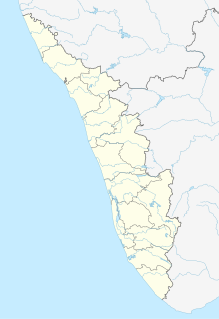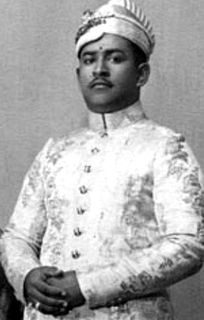
The Kingdom of Travancore (Thiruvithamkoor) was an Indian kingdom from c. 870 CE until 1949 CE. It was ruled by the Travancore Royal Family from Padmanabhapuram, and later Thiruvananthapuram. At its zenith, the kingdom covered most of modern-day central and southern Kerala with the Thachudaya Kaimal's enclave of Irinjalakuda Koodalmanikyam temple in the neighbouring Kingdom of Cochin, as well as the district of Kanyakumari, now in the Indian state of Tamil Nadu. The official flag of the state was red with a dextrally-coiled silver conch shell at its center.

Sree Padmanabhadasa Sree Chithira Thirunal Balarama Varma, popularly known as Sree Chithira Thirunal, was the last ruling Maharaja of the Princely State of Travancore, in southern India until 1949 and later the Titular Maharajah of Travancore until 1991. Sree Chithira Thirunal was the eldest son of Junior Maharani of Travancore, H.H. Sree Padmanabhasevini Vanchidharmavardhini Rajarajeshwari Maharani Moolam Thirunal Sethu Parvathi Bayi, and Sri Pooram Nal Ravi Varma Koyi Thampuran of the Royal House of Kilimanoor. He was privately educated, and became the Maharajah of Travancore, at the age of 12, upon the death of his maternal great uncle, the then Maharajah of Travancore Sree Moolam Thirunal, on 7 August 1924. He reigned under the regency of his maternal aunt, Sethu Lakshmi Bayi (1924–31), until he came of age and was invested with full ruling powers on 6 November 1931.

The Padmanabhaswamy temple is a Hindu temple located in Thiruvananthapuram, the state capital of Kerala, India. The name of the city of Thiruvananthapuram in Malayalam translates to "The City of Lord Ananta", referring to the deity of the Padmanabhaswamy temple. The temple is built in an intricate fusion of the Chera style and the Dravidian style of architecture, featuring high walls, and a 16th-century gopura. While the Ananthapura temple in Kumble is considered the original seat of the deity ("Moolasthanam"), architecturally to some extent, the temple is a replica of the Adikesava Perumal temple in Thiruvattar.

Bhadrakālī is a Hindu goddess popular in Southern India. She is one of the fierce forms of the Great Goddess Shakti or Adi Parashakti mentioned in the Devi Mahatmyam. Bhadrakali is a popular form of the Great Goddess, worshipped in Kerala as Bhadrakali, Mahakali, Chamunda and Kariam Kali Murti. In Kerala she is seen as the auspicious and fortunate form of Mahakali who protects the good.

Karamana is a suburb of Thiruvananthapuram (Trivandrum), the capital city of Kerala, India. It is one of the most densely populated, but green part of Thiruvananthapuram. The land of Karamana is made fertile by the river, Karamana River which starts from the southern tip of the Western Ghats at "Agastyakoodam". The river flows 68 km westward and merges into the Arabian Sea at Thiruvallom-Karumam area near Kovalam.The Juma Masjid in Karamana is a famous landmark. Karamana is also known for its busy "Daily market" and is a major transit point for both trade and people travelling to or coming in from the Kanyakumari district of neighbouring Tamil Nadu.

The East Fort is located at the heart of the CBD of Thiruvananthapuram city, the capital city of Kerala- a South Indian state.
The history of Thiruvananthapuram dates back to the 10th century AD. The city and several other places in the district occupy an important place in ancient tradition, folklores and literature of the State of Kerala.

Mulam Thirunal Rama Varma was the ruling Maharajah of the Indian state of Travancore between 1885 and 1924, succeeding his uncle Maharajah Visakham Thirunal (1880–1885).

Sreekanteswaram is a place in Thiruvananthapuram city (Trivandrum), India. The place is known for the Siva temple, from which the name was derived. Pazhaya Sreekanteswaram Temple is the original abode of the Lord of new Sreekanteswaram Mahadeva Temple. Author of Sabdatharavali, Sreekanteswaram Padmanabha Pillai hails from this place.
The Ettara Yogam or the King and Council of Eight has been the administrative setup of Sri Padmanabhaswamy Temple for centuries.
Vilwamangalam Swamiyar or Vilwamangalathu Swamiyar is the name of more than one saint who lived in India. The first Vilwamangalam, a Swamiyar belonging to Naduvil Madhom, who lived in the 8th century. The spot of his samadhi is to the west of Sree Padmanabhaswamy Temple. The second saint who belonged to Thekke Madhom,Thrissur lived during the middle of 14th century. He was an ardent devotee of Lord Guruvayoorappan. Both the Swamiyars were native to Malai Nadu. The first Swamiyar was born in Sukapuram Gramam in Kerala. The second Swamiyar was renowned all over India. Bengalis believe that he was born in Bengal while Oriyans believe in Orissa, though tradition in Kerala implies that he belonged to Panniyoor village. "Sreekrishna Karnamritham" is his devotional masterpiece, written under an unspecified name "Leelasukan". The second Vilwamangalam is closely associated with several famous temples in Kerala such as Thiruvarppu, and Cherthala Kaarthiaayani.

Sree Padmanabhadasa Sree Uthradom Thirunal Marthanda Varma was the titular Maharaja of Travancore. He was the younger brother of the last ruling monarch of the Kingdom of Travancore, Maharajah Chithira Thirunal Balarama Varma.

The Travancore Royal Family was the ruling house of the Kingdom of Travancore. They lost their ruling rights in 1949 when Travancore merged with the Indian Union and their remaining privileges were abolished by the Indian Union in 1971. The family are descended from the Ay/Venad family, Cheras, Pandyas and Cholas. The ruler in that bloodline was Maharaja Sree Moolam Thirunal, as the family of Maharaja Chithira Thirunal and successors.

Irumkulangara Durga Bhagavathi Temple is a Hindu temple in Thottam, Manacaud, Manacaud P.O, Thiruvananthapuram, Kerala, India. It is about 1.8 kilometres to the southwest of Sree Padmanabhaswamy Temple in Thiruvananthapuram city.

Pillai, meaning Prince, is a title of nobility which can either refer to a ruling chief, members of the nobility, or junior princes of the royal family historically ranked immediately below the king. The oldest lineages of Pillais include not only Kshathriyas but also brahmins who took up the sword. From the early modern period, the title also came to be bestowed on Savarna subjects by the ruling families of Kerala for services military or political, most of whom were of Nair origin.
Kanthaloor Mahadeva Temple, Valiyasala is one of the ancient Trimurti temples in Thiruvananthapuram. Kanthaloor Sala, a famous university, was located here centuries back.
Kanjirottu Yakshi (Sreedevi) is a folkloric vampire. According to the myth, she was born into an affluent Padamangalam Nair tharavad by name Mangalathu at Kanjiracode in Southern Travancore. Being a ravishingly beautiful courtesan she had an intimate relationship with Raman Thampi, son of King Rama Varma and rival of Anizhom Thirunal Marthanda Varma. According to the story, she was murdered by her servant and she turned into a Yakshi, waylaying men with her beauty and drinking their blood.
Sreekanteswaram Mahadeva Temple is an ancient Shiva temple situated in Thiruvananthapuram, in the Indian state of Kerala. Pazhaya Sreekanteswaram Temple is the original abode of the Lord.
Sreekanteswaram Mahadeva Temple is a Hindu temple situated in the heart of Thiruvananthapuram in the Indian state of Kerala. This temple is more than 700 years old. It is dedicated to Shiva and is within 3 km of the Central Railway Station, bus station, East Fort and Sree Padmanabhaswamy Temple.












